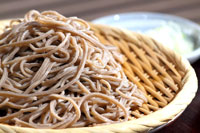

Продавцу. Производителю -
03.04.2018 14:11
 В свое время МОО РДА рекомендовала потребление ряда макаронных изделий двух зарубежных фирм (гречишные, ржаные, рисовые, с отрубями и иные) с низким гликемическим индексом здоровым потребителям. К сожалению, эти производители ушли из нашей страны. Любителям пасты (макарон) не обязательно отказываться от нее во время диеты. Кто же из отечественных производителей восстановит неудовлетворенный спрос?
В свое время МОО РДА рекомендовала потребление ряда макаронных изделий двух зарубежных фирм (гречишные, ржаные, рисовые, с отрубями и иные) с низким гликемическим индексом здоровым потребителям. К сожалению, эти производители ушли из нашей страны. Любителям пасты (макарон) не обязательно отказываться от нее во время диеты. Кто же из отечественных производителей восстановит неудовлетворенный спрос?
Результаты исследования, проведенного группой специалистов из Торонтского университета и больницы Святого Михаила (Торонто, Канада), обнародованы в журнале British Medical Journal Open. Ученые проанализировали 30 исследований, в которых участвовали 2 500 человек. Все эти люди сидели на диете, в которой паста была единственным источником углеводов в их рационе. В среднем участники съедали по 3 порции в неделю (одна порция — около получашки). В итоге за четыре месяца испытуемые сбросили в среднем по полкилограмма. У макарон низкий гликемический индекс, чем можно объяснить их диетический эффект. В отличие от большинства очищенных углеводов, которые быстро всасываются в кровь, они усваиваются медленнее и не вызывают резкого подъема уровня сахара в крови, а значит, не приводят к отложению жира, объясняют специалисты.
В то же время ученые признают, что участники исследования питались едой с низким гликемическим индексом. Чтобы понять, как паста влияет на вес в других диетах, требуются дальнейшие исследования.
Ранее британские специалисты заявили, что макароны можно потреблять даже вечером на ужин.
Abstract
Effect of pasta in the context of low-glycaemic index dietary patterns on body weight and markers of adiposity: a systematic review and meta-analysis of randomised controlled trials in adults
1. Laura Chiavaroli1,2,
2. Cyril W C Kendall1,2,3,
3. Catherine R Braunstein1,2,
4. Sonia Blanco Mejia1,2,
5. Lawrence A Leiter1,2,4,5,6,
6. David J A Jenkins1,2,4,5,6,
7. John L Sievenpiper1,2,4,5,6
Objective Carbohydrate staples such as pasta have been implicated in the obesity epidemic. It is unclear whether pasta contributes to weight gain or like other low-glycaemic index (GI) foods contributes to weight loss. We synthesised the evidence of the effect of pasta on measures of adiposity.
Design Systematic review and meta-analysis using the Grading of Recommendations Assessment, Development, and Evaluation (GRADE) approach.
Data sources MEDLINE, Embase, CINAHL and the Cochrane Library were searched through 7 February 2017.
Eligibility criteria for selecting studies We included randomised controlled trials ≥3 weeks assessing the effect of pasta alone or in the context of low-GI dietary patterns on measures of global (body weight, body mass index (BMI), body fat) and regional (waist circumference (WC), waist-to-hip ratio (WHR), sagittal abdominal diameter (SAD)) adiposity in adults.
Data extraction and synthesis Two independent reviewers extracted data and assessed risk of bias. Data were pooled using the generic inverse-variance method and expressed as mean differences (MDs) with 95% CIs. Heterogeneity was assessed (Cochran Q statistic) and quantified (I2 statistic). GRADE assessed the certainty of the evidence.
Results We identified no trial comparisons of the effect of pasta alone and 32 trial comparisons (n=2448 participants) of the effect of pasta in the context of low-GI dietary patterns. Pasta in the context of low-GI dietary patterns significantly reduced body weight (MD=−0.63 kg; 95% CI −0.84 to –0.42 kg) and BMI (MD=−0.26 kg/m2; 95% CI −0.36 to –0.16 kg/m2) compared with higher-GI dietary patterns. There was no effect on other measures of adiposity. The certainty of the evidence was graded as moderate for body weight, BMI, WHR and SAD and low for WC and body fat.
Conclusions Pasta in the context of low-GI dietary patterns does not adversely affect adiposity and even reduces body weight and BMI compared with higher-GI dietary patterns. Future trials should assess the effect of pasta in the context of other ‘healthy’ dietary patterns.
Trial registration number NCT02961088; Results.
This is an Open Access article distributed in accordance with the Creative Commons Attribution Non Commercial (CC BY-NC 4.0) license, which permits others to distribute, remix, adapt, build upon this work non-commercially, and license their derivative works on different terms, provided the original work is properly cited and the use is non-commercial. See: http://creativecommons.org/licenses/by-nc/4.0/
http://dx.doi.org/10.1136/bmjopen-2017-019438
Nutrition and metabolism
Research
Effect of pasta in the context of low-glycaemic index dietary patterns on body weight and markers of adiposity: a systematic review and meta-analysis of randomised controlled trials in adults
1. Laura Chiavaroli1,2,
2. Cyril W C Kendall1,2,3,
3. Catherine R Braunstein1,2,
4. Sonia Blanco Mejia1,2,
5. Lawrence A Leiter1,2,4,5,6,
6. David J A Jenkins1,2,4,5,6,
7. John L Sievenpiper1,2,4,5,6
Author affiliations
Abstract
Objective Carbohydrate staples such as pasta have been implicated in the obesity epidemic. It is unclear whether pasta contributes to weight gain or like other low-glycaemic index (GI) foods contributes to weight loss. We synthesised the evidence of the effect of pasta on measures of adiposity.
Design Systematic review and meta-analysis using the Grading of Recommendations Assessment, Development, and Evaluation (GRADE) approach.
Data sources MEDLINE, Embase, CINAHL and the Cochrane Library were searched through 7 February 2017.
Eligibility criteria for selecting studies We included randomised controlled trials ≥3 weeks assessing the effect of pasta alone or in the context of low-GI dietary patterns on measures of global (body weight, body mass index (BMI), body fat) and regional (waist circumference (WC), waist-to-hip ratio (WHR), sagittal abdominal diameter (SAD)) adiposity in adults.
Data extraction and synthesis Two independent reviewers extracted data and assessed risk of bias. Data were pooled using the generic inverse-variance method and expressed as mean differences (MDs) with 95% CIs. Heterogeneity was assessed (Cochran Q statistic) and quantified (I2 statistic). GRADE assessed the certainty of the evidence.
Results We identified no trial comparisons of the effect of pasta alone and 32 trial comparisons (n=2448 participants) of the effect of pasta in the context of low-GI dietary patterns. Pasta in the context of low-GI dietary patterns significantly reduced body weight (MD=−0.63 kg; 95% CI −0.84 to –0.42 kg) and BMI (MD=−0.26 kg/m2; 95% CI −0.36 to –0.16 kg/m2) compared with higher-GI dietary patterns. There was no effect on other measures of adiposity. The certainty of the evidence was graded as moderate for body weight, BMI, WHR and SAD and low for WC and body fat.
Conclusions Pasta in the context of low-GI dietary patterns does not adversely affect adiposity and even reduces body weight and BMI compared with higher-GI dietary patterns. Future trials should assess the effect of pasta in the context of other ‘healthy’ dietary patterns.
Trial registration number NCT02961088; Results.
http://dx.doi.org/10.1136/bmjopen-2017-019438
Поделиться ссылкой:

You have no rights to post comments







 Youtube
Youtube
 Telegram
Telegram

.png)






































 В свое время МОО РДА рекомендовала потребление ряда макаронных изделий двух зарубежных фирм (гречишные, ржаные, рисовые, с отрубями и иные) с низким гликемическим индексом здоровым потребителям. К сожалению, эти производители ушли из нашей страны. Любителям пасты (макарон) не обязательно отказываться от нее во время диеты. Кто же из отечественных производителей восстановит неудовлетворенный спрос?
В свое время МОО РДА рекомендовала потребление ряда макаронных изделий двух зарубежных фирм (гречишные, ржаные, рисовые, с отрубями и иные) с низким гликемическим индексом здоровым потребителям. К сожалению, эти производители ушли из нашей страны. Любителям пасты (макарон) не обязательно отказываться от нее во время диеты. Кто же из отечественных производителей восстановит неудовлетворенный спрос?
